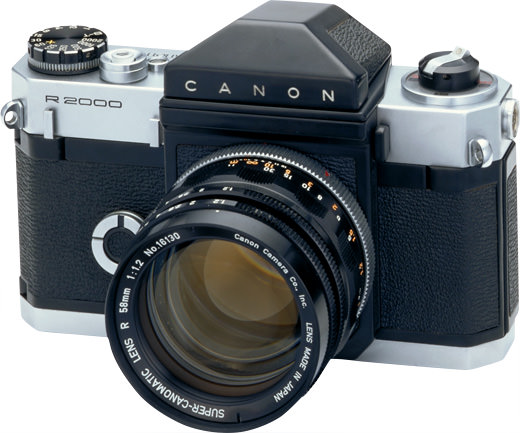
Deluxe version of the Canonflex. With a top shutter speed of 1/2000 sec., the fastest ever for any camera, the R2000 was a high-performance 35mm SLR. Other than that, it was the same as the original Canonflex. The viewfinder used a Fresnel matte focusing screen without a rangefinder.
| Shutter | - |
| Viewfinder | - |
| - Magnification | - |
| - Coverage | - |
| Power | - |
| Size | - |
| Weight | -- |
According to reports from Canon, 14,000 units of the R2000 were built but only 8721 were available for sale. Serial numbers started at 50001. Even though the Internet Directory of Camera Collectors claims that serial numbers began with 50646 mine is 50488, so clearly that is incorrect. They also claim that the last serial number was 59281, but other R2000 owners have numbers over 59400. I imagine that some had flaws and were destroyed. But Canon is clear that only 8721 were put up for sale. The Canon Museum website can give you all the specs on the camera so I will not bother with those details. The R2000 is arguably the first commercially available camera with a top speed of 1/2000th, thus its name. It is the second to last of the four Canonflex cameras built and mark Canon's entry into SLRs. The first three models do not have a built-in light meter, but an attachable external selenium meter was available for the Canonflex and Canonflex RP. That meter maxed at 1/1000th. The external selenium meter for the R2000 maxed at 1/2000th although the other meters would work. The Canonflex RM has a built-in selenium meter and was the last of the line. The RM replaced the R2000 in 1962 before being replaced by the FX in 1964. The R2000 is extremely well built and was produced to compete with the Nikon F as professional camera. An eye-level and waist-level finder were both available and attaching and detaching the finder is quite simple. A lever is depressed on the left side of the camera face and the finder slides out. The layout of the camera is simple, too. The top right-hand side has the shutter speed, frame counter, and shutter button. The frame counter counts up from zero. The left-hand side has a rewind lever. Pulling up the lever gives access to set the ASA/DIN and to set another dial for BW, Color, or Tungsten film. The front of the camera has a self-timer. The bottom has the rewind button, tripod mount on the right, and lever to open the back of the camera. which is folded out and turned to unlock (or lock) the back. Film advance is on the bottom of the camera too. A small metal flap is unfolded allowing one to advance the film with the pinky finger of the right hand. Super Canomatic R lenses are used and are the only lenses that fit on the Canonflex bodies. FL and FD lenses can damage the body--and probably the lens. The R lenses have SC coating. The widest angle is 35mm and the narrowest is 1000mm. Three zoom lenses were available. The lenses have two aperture rings--one is to preset the aperture while the other allows for viewing depth of field. That ring needs to be set back to the widest aperture before firing the shutter. I only own the 50mm f1.8 mark III. While the lenses seem to be very well built, some claim they are more prone to failure than the FL and FD lenses. That might just be age. My lens works great although at first I thought the preset ring was stiff. I now think that is normal to prevent accidental movement. My copy looks as though it was never used although the light seals were replaced. This is not a TTL camera/lens combo so using filters requires knowledge of the filter factor. I leave a Y1 on the lens for protection which has a 1.5X factor equivalent to about 2/3rds of a stop. I am looking for a working meter but now simply use the sunny 16 method. Since lenses are hard to find and often suspect, I would not recommend this camera unless you are a collector or stumble across one cheap. Nonetheless, I love it.